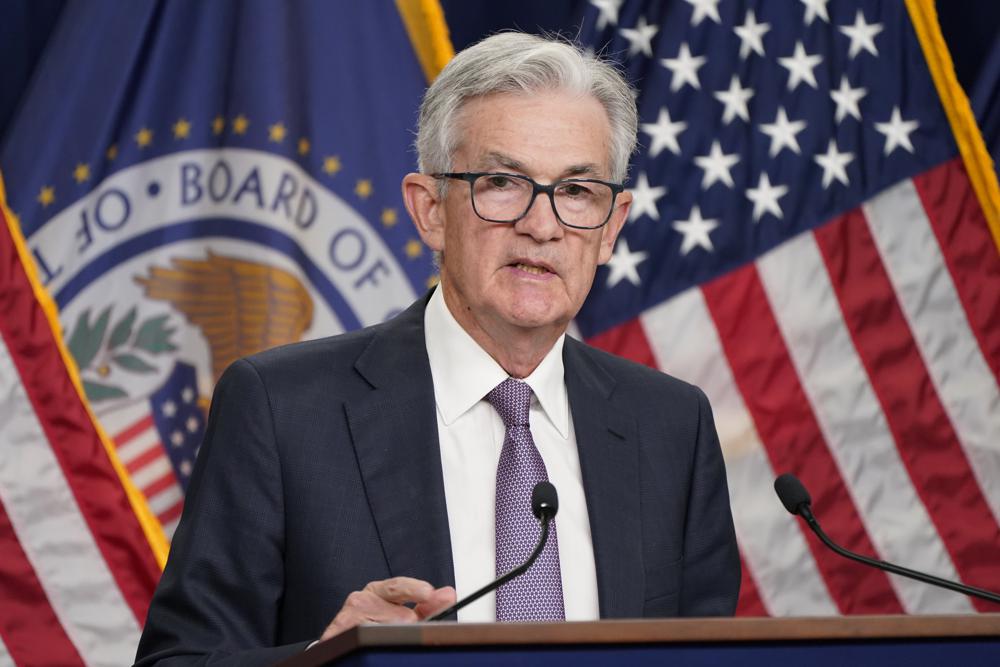Federal Reserve Chair Jerome Powell sought Wednesday to strike a delicate balance at a moment when high inflation is bedeviling the nation’s economy and commanding a central role in the midterm elections.
Powell suggested that the Fed may decide in coming months to slow its aggressive interest rate increases. Yet he also made clear that the Fed isn’t even close to declaring victory in its fight to curb an inflation rate that is near four-decade highs and has shown few signs of ebbing.
When the Fed ended its latest policy meeting Wednesday, it announced that it was pumping up its benchmark rate by a substantial three-quarters of a point for a fourth straight time. Its key rate now stands in a range of 3.75% to 4%, the highest in 15 years.
It was the central bank’s sixth rate hike this year — a streak that has made mortgages and other consumer and business loans increasingly expensive and heightened the risk of a recession.
The statement the Fed issued suggested that it would begin to take a more deliberate approach to rate hikes, likely leading to smaller increases in borrowing costs. In doing so, it would consider that rate hikes take time to feed into the economy and achieve their goal of slowing inflation.
The financial markets initially cheered the notion that the Fed might soon decide to slow its hikes, with stock and bond prices surging higher.
Yet as his news conference got under way, Powell struck a harder line. He stressed that the Fed’s policymakers have seen little progress in their efforts to control inflation and would likely have to send rates even higher than they thought they would at their last meeting in September.
“We still have some ways to go,” he said. “Incoming data since our last meeting suggests” that the officials might have to raise rates higher than the 4.6% they forecast in September.
The Fed chair pointedly emphasized that it would be “very premature” to even think about halting the rate hikes. Inflation pressures, he said, remain far too high.
The abrupt shift in tone gave the financial markets whiplash. Stocks sharply reversed their gains and tumbled into the close of trading. The Dow Jones Industrial Average ended the day down over 500 points, or about 1.5%.
“I think he accomplished his goal” of striking hawkish and dovish notes, said Vince Reinhart, chief economist at Dreyfus and Mellon. (“Hawks” generally prefer higher rates to fight inflation, while “doves” often lean more toward lower rates to support hiring.) “That’s why the market was so confused.”
The Fed’s meeting occurred as financial markets and many economists have grown nervous that Powell will end up leading the central bank to raise borrowing costs higher than needed to tame inflation and will cause a painful recession in the process.
Powell implicitly addressed those fears at his news conference. He kept the door open to downshifting to a half-point hike when the Fed next meets in December. The central bank could then step down even further to a quarter-point increase — a more typically sized rate hike — early next year.
“At some point,” he said, “it will become appropriate to slow the pace of increases. So that time is coming, and it may come as soon as the next meeting or the one after that. No decision has been made.”
At the same time, Powell noted that the job market remains strong, which means many businesses must raise pay to keep workers — raises that are often passed on to consumers in the form of higher prices.
This week, the government reported that companies posted more job openings in September than in August. There are now 1.9 available jobs for each unemployed worker, an unusually large supply, which also fuels bigger pay increases and adds to inflationary pressures.
Overall, Powell said the Fed has made little progress against inflation so far.
“We think we have a ways to go, we have some ground to cover with interest rates,” he continued, “before we get to that level of interest rates that we think is sufficiently restrictive.”
The persistence of inflated prices and higher borrowing costs is pressuring American households and has undercut the ability of Democrats to campaign on the health of the job market as they try to keep control of Congress. Republican candidates have hammered Democrats on the punishing impact of inflation in the run-up to the midterm elections that will end Tuesday.
“Chair Powell stuck to this two-pronged message: We’re not done yet, due to high inflation and a strong commitment to bring it down,” Sal Guatieri, senior economist at BMO Capital Markets Economics, wrote in a note. “But we may not need to keep cranking rates aggressively, due to an economy that has slowed significantly from last year and long-term inflation expectations that are still ‘well anchored.’ ”
Typically, the Fed raises rates in quarter-point increments. But after having miscalculated in downplaying inflation last year as likely transitory, Powell has led the Fed to raise rates aggressively to try to slow borrowing and spending and ease price pressures.
The average rate on a 30-year fixed mortgage, just 3.14% a year ago, surpassed 7% last week, mortgage buyer Freddie Mac reported. Sales of existing homes have dropped for eight straight months.
Still, the policymakers may feel they can soon slow the pace of their rate hikes because some early signs suggest that inflation could start declining in 2023. Consumer spending, squeezed by high prices and costlier loans, is barely growing. Supply chain snarls are easing, which means fewer shortages of goods and parts. Wage growth is plateauing, which, if followed by declines, would reduce inflationary pressures.
Outside the United States, many other major central banks are also rapidly raising rates to try to cool inflation levels that are even higher than in the U.S.
Last week, the European Central Bank announced its second consecutive jumbo rate hike, increasing rates at the fastest pace in the euro currency’s history to try to curb inflation that soared to a record 10.7% last month.
Likewise, the Bank of England is expected to raise rates Thursday to try to ease consumer prices, which have risen at their fastest pace in 40 years, to 10.1% in September. Even as they raise rates to combat inflation, both Europe and the U.K. appear to be sliding toward recession.
(AP)











